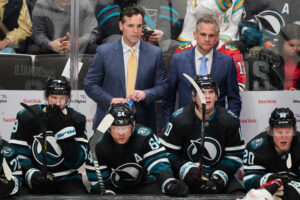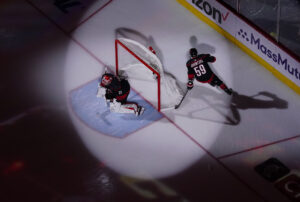The ghost of Curtis McElhinney haunts the Toronto Maple Leafs. Since general manager Kyle Dubas made the decision to go with Garret Sparks instead of McElhinney prior to the 2018-19 season, the Leafs backup goalie position has been a wasteland in Toronto. The position has cost the team valuable wins, affecting their playoff positioning and robbing them of home ice advantage.
Last season in the playoffs, the team was forced to travel to Boston’s cursed rink for Game 7. Inferior backup goaltending was a central reason why the game was in Boston instead of Toronto. Predictably, history tragically repeated itself. This season, the same problem is threatening the Leafs’ chances of even making the playoffs.
Toronto Maple Leafs Backup Goalie Mistake
The Significance of the Backup Goalie
The backup goalie is hockey’s forgotten man. Most of the time, they toil in relative obscurity. When they do surface, usually about once every couple of weeks, their job is typically to defeat the weaker opponent during a back-to-back. These days, backups are gaining additional relevance, particularly for teams with oft-injured starters or playoff aspirations. They provide critical rest for starting goaltenders.
The backup goalie position requires a specialized skill set. Starting netminders can use repeated game action to get into a rhythm and stay sharp. Backups do not have that luxury. They are often forced into action after long periods without game exposure. They have to be able to use practice to simulate game action.
Backup goalies must stay mentally sharp and be ready for their opportunities whenever they arise. Achieving such consistent focus without regular game action requires a unique level of mental maturity and stability. Teams cannot just plug any goalie in as a backup and expect them to be successful.
Approach to the Leafs Backup Goalie Position
Yet that is precisely what the Maple Leafs have tried to do since cutting Curtis McElhinney prior to the 2018-19 season. Following their playoff exit to the Boston Bruins that year, Kyle Dubas decided to promote Garret Sparks to the backup position with the big club. Garret Sparks had just won the Calder Cup with the Toronto Marlies. His performance enabled many to regard him as a potential starting goalie.
Despite this, the decision surprised some at the time. Curtis McElhinney was coming off a career year with the Leafs, during which he sported an elite goals against average of 2.14, and a stellar save percentage of .934. He had proven to be an elite and reliable backup goaltender for the Leafs.
Following Dubas’ decision, Garret Sparks struggled in the backup role. Similar to many young and inexperienced goaltenders, his performance was predictably inconsistent. Glaring technical weaknesses overshadowed moments of solid play. These included a propensity to open his five-hole too wide and over pursue pucks. After one season with the team, the Leafs lost patience with him. He was traded to the Vegas Golden Knights for David Clarkson’s contract and a fourth-round pick.
This season, the Leafs have deployed Michael Hutchinson and Kasimir Kaskisuo as backup goaltenders. They have gone a combined 0-6-1 with a 4.74 GAA and a .870 save percentage. Their abysmal goaltending has cost the team valuable points in the standings.
By contrast, Curtis McElhinney was stellar during the 2018-19 season, during which he put up solid numbers while starting 38 games with the Carolina Hurricanes. He was also fantastic in the playoffs that year, when he posted a 2.01 GAA and a .930 save percentage and won three games for the Hurricanes. While he has struggled somewhat this year with the Tampa Bay Lightning, his save percentage coming into this week was still better than either of the Leafs’ current options.
Analysis
Some argue that at the time, the Leafs had little choice but to choose Sparks over McElhinney. Proponents of this theory cite Sparks’ young age relative to McEhinney, and his considerable success in the AHL with the Toronto Marlies. They also rightly point out the salary cap crunch the Leafs have put themselves in with the contracts of Mitch Marner, William Nylander, and Auston Matthews. Their large contracts currently restrict the amount of cap space the Leafs have to spend on backup goaltending.
However, in hindsight, it is clear that the Maple Leafs made the wrong decision. At the time they waived McElhinney, those players were all unsigned. Yes, the Leafs had to reserve significant space for their contracts. But they were not yet a solid impediment to spending at the backup goalie position. Moreover, McElhinney’s cap hit in the 2018-19 season was $850,000. Garret Sparks’ cap hit was $700,000. The difference in salary was only $150,000. Keeping McElhinney would have stabilized the position in the short term, without dramatically affecting the team’s negotiations with their star players at the time.
Furthermore, Frederik Andersen, the team’s dependable starting goalie, was under contract through the 2020-21 season. While some thought Garret Sparks had the potential to develop into a starter, at the time Dubas made the decision to keep him over McElhinney, there was no upcoming need for another starting goaltender. As well, grooming a potential starter out of the backup position, where goalies can get sporadic playing time, made little sense.
Lousy play at the backup goalie position can also overwork a starting goalie and endanger their health. The performance of Toronto’s backups this season recently forced Sheldon Keefe to deploy Frederik Andersen in back-to-back games. Given the team’s dependence on Andersen and his significant injury history, this strategy is fraught with peril and should be used sparingly. It is not a long term solution to the problem.
Final Thought
In rebuilding their team, the Toronto Maple Leafs have done a lot of things right. The Leafs have put together an elite offence, with a seemingly endless supply of talented forwards. When healthy, they have one of the most dependable starting goaltenders in the league in Frederik Andersen. They have made the playoffs three seasons in a row, improving noticeably each year prior to this one. There is much to like about the team and its direction.
However, there are still some undeniable flaws with the team’s roster. Chief among those is the lack of a capable backup goaltender. This flaw becomes more glaring when one considers that the Leafs defensive zone coverage can sometimes be leakier than the Trump administration.
Competent backup goaltending is essential to ensure rest for the starter, and in optimizing a team’s position in the standings. The Leafs chose to keep Garret Sparks over Curtis McElhinney while they already had a contending team. In making this choice, it is arguable that the Leafs did not properly value the importance of stable play from the backup goaltending position.
Unless the Leafs find a backup capable of winning hockey games, they are in serious danger of missing the playoffs. At the very least, they are facing a much tougher road to the Stanley Cup. The backup goalie is hockey’s forgotten man. The Leafs appear to have forgotten him too.
Main Photo:






